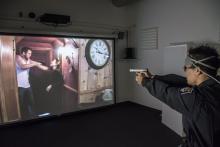Archival Notice
This is an archive page that is no longer being updated. It may contain outdated information and links may no longer function as originally intended.
One of the most significant — but least understood — realities of research in the social and behavioral sciences is how difficult it can be to identify specific, causal relationships, especially when examining the impact of a particular program. In fact, in all the sciences, small incremental progress is far more common than breakthroughs. That’s why I’m so pleased when I see examples of NIJ’s role in driving innovative research in policing and other stressful occupations, such as serving in the military or on crisis intervention teams.

Two decades ago, NIJ funded Dr. Vila and his colleagues to assess the impact of fatigue, shift work and long hours on the ability of police officers to perform critical tasks and on police officers’ relationships with the community. As the research matured, it became clear that better measurement was needed to assess officer performance and the novel SHOT simulation lab was built to develop innovative measurement techniques. In 2008, the Office of Naval Research (ONR) funded the SHOT research team to expand that work and purchase additional instrumentation and simulators to improve measurements and documentation in the lab.Recently, I had a chance to visit with Dr. Bryan Vila, a former police officer turned professor at Washington State University, and tour the Simulated Hazardous Operational Tasks (SHOT) Laboratory he oversees within the Sleep and Performance Research Center. The work conducted at the SHOT laboratory is an excellent example of how innovative ideas can create knowledge-generating hubs for the field. In this case, the hub supports a crucial research area: the safety and wellness of police officers and the communities they serve.
Seeing the success that the SHOT lab had on assessing officer fatigue, the team received additional funding from NIJ in 2008 to develop metrics to better understand how police officers perform during deadly force encounters. Other federal sources provided funding to even further build on NIJ’s initial investments. The Defense Advanced Research Projects Agency (DARPA), for example, was interested in developing metrics for understanding tactical social interactions, including how soldiers can become more adept when interacting with people in another culture. And, recently, the lab secured a Spokane city grant to develop metrics for measuring the performance of crisis intervention teams.
The development and refinement of the SHOT lab’s methodology shows how small incremental progress can lead to further investments and the creation of important knowledge. Put simply, this progress has helped us better understand police performance, which led to interest from the military on soldier performance, which led to interest from other fields that must operate around the clock, such as crisis intervention teams. As NIJ Director, I am extremely proud that our initial investment in the nation’s first rigorous, large-scale experimental study on the impact of fatigue on judgment and decision-making has spurred other innovative research. The recent findings from the SHOT lab are now being used around the country to inform policies and practices related to:
- Operational driving with and without distraction.
- Driving during extended work shifts and driving on the way home.
- Tactical social interaction.
- Deadly force judgment and decision-making.
- The role of implicit racial bias on behavior in realistic simulations of deadly force encounters.
During my recent tour of the laboratory, Dr. Vila said, “This is a story of NIJ identifying a novel, pervasive and pernicious problem that had been overlooked since the beginning of modern policing. It’s also a story of how NIJ funding was leveraged by a factor of 10 or more with funding from NIOSH [the National Institute for Occupational Safety and Health], NIMH [the National Institute of Mental Health], ONR and DARPA to find workable solutions.”
Throughout the past decade, the researchers at the SHOT lab have demonstrated exceptional interdisciplinary applications. I applaud their deep commitment to advance the field by recognizing the important intersection of wellness, health and public safety, not only for law enforcement officers, but also soldiers and other professionals who work long hours in highly stressful situations.
Building strong evidence to help improve law enforcement policies and procedures doesn’t happen overnight. It requires strategic thinking and a steady course — and, of course, committed funders and scholars like the researchers at the SHOT laboratory.

